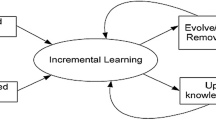Abstract
Incremental learning is mostly accomplished by an incremental model relying on appropriate and adjustable architecture. The present paper introduces a hybrid evolving architecture for dealing with incremental learning. Consisting of two sequential and incremental learning modules: growing Gaussian mixture model (GGMM) and resource allocating neural network (RAN), the rationale of the architecture rests on two issues: incrementality and the possibility of partially labeled data processing in the context of classification. The two modules are coherent in the sense that both rely on Gaussian functions. While RAN trained by the extended Kalman filter is used for prediction, GGMM is dedicated to self-learning or pre-labeling of unlabeled data using a probabilistic framework. In addition, an incremental feature selection procedure is applied for continuously choosing the meaningful features. The empirical evaluation of the cascade studies various aspects in order to discuss the efficiency of the proposed hybrid learning architecture.














Similar content being viewed by others
Notes
These two stages might be split into three as is the case in some proposals.
With special acknowledgment to Prof. Hagras and Dr. Doctor for furnishing this study with the iDorm data.
References
Arandjelovic O, Cipolla R (2005) Incremental learning of temporally coherent gaussian mixture models. In: Proceedings of the the 16th British machine vision conference, pp 759–768
Banfield J, Raftery A (1993) Model-based Gaussian and non-Gaussian clustering. Biometrics 49:803–821
Bouchachia A (2008a) Incremental learning. In: Encyclopedia of data warehousing and mining, 2nd edn, Idea-group, pp 1006–1012
Bouchachia A (2008b) Learning with partial supervision. In: Encyclopedia of data warehousing and mining, 2nd edn, Idea-group, pp 1150–1157
Bouchachia A (2009) Incremental induction of fuzzy classification rules. In: IEEE workshop on evolving and self-developing intelligent systems, pp 32–39
Bouchachia A, Mittermeir R (2006) Towards fuzzy incremental classifiers. Soft Comput 11(2):193–207
Bouchachia A, Pedrycz W (2006) Enhancement of fuzzy clustering by mechanisms of partial supervision. Fuzzy Sets Syst 735(13):776–786
Chapelle O, Schölkopf B, Zien A (eds) (2006) Semi-supervised learning. MIT Press, Cambridge
De R, Pal N, Pal S (1997) Feature analysis: neural network and fuzzy set theoretic approaches. Pattern Recognit 30(10):1579–1590
Declercq A, Piater J (2008) Online learning of gaussian mixture models—a two-level approach. In: Proceedings of the third international conference on computer vision theory and applications, pp 605–611
Duda P, Hart E, Stork D (2001) Pattern classification. Wiley, New York
Hall P, Hicks Y (2004) A method to add gaussian mixture models. Technical report, University of Bath
Kadirkamanathan V, Niranjan M (1993) A function estimation approach to sequential learning with neural networks. Neural Comput 5(6):954–975
Lee D (2005) Effective Gaussian mixture learning for video background subtraction. IEEE Trans Pattern Anal Mach Intell 27(5):827–832
Platt J (1991) A resource allocation network for function interpolation. Neural Comput 3(2):213–225
Radford N, Hinton G (1999) A view of the EM algorithm that justifies incremental, sparse, and other variants. In: Learning in graphical models. MIT Press, Cambridge, pp 355–368
Roberts S, Holmes C, Denison D (2001) Minimum-entropy data partitioning using reversible jump markov chain monte carlo. IEEE Trans Pattern Anal Mach Intell 23(8):909–914
Song M, Wang H (2005) Highly efficient incremental estimation of gaussian mixture models for online data stream clustering. In: Intelligent computing: theory and applications. SPIE, pp 174–183
Stauffer C, Grimson W (1999) Adaptive background mixture models for real-time tracking. In: Proceedings of the IEEE conference on computer vision and pattern recognition, pp 246–252
Stauffer C, Grimson W (2000) Learning patterns of activity using real-time tracking. IEEE Trans Pattern Anal Mach Intell 22(8):747–757
Widmer G, Kubat M (1996) Learning in the presence of concept drift and hidden contexts. Mach Learn 23:69–101
Yang Z, Zwolinski M (2001) Mutual information theory for adaptive mixture models. IEEE Trans Pattern Anal Mach Intell 23(4):396–403
Yingwei L, Sundararajan N, Saratchandran P (1998) Performance evaluation of a sequential minimal radial basis function (rbf) neural network learning algorithm. IEEE Trans Neural Netw 9(2):308–318
Author information
Authors and Affiliations
Corresponding author
Rights and permissions
About this article
Cite this article
Bouchachia, A. An evolving classification cascade with self-learning. Evolving Systems 1, 143–160 (2010). https://doi.org/10.1007/s12530-010-9014-x
Received:
Accepted:
Published:
Issue Date:
DOI: https://doi.org/10.1007/s12530-010-9014-x




